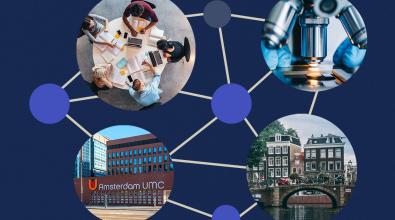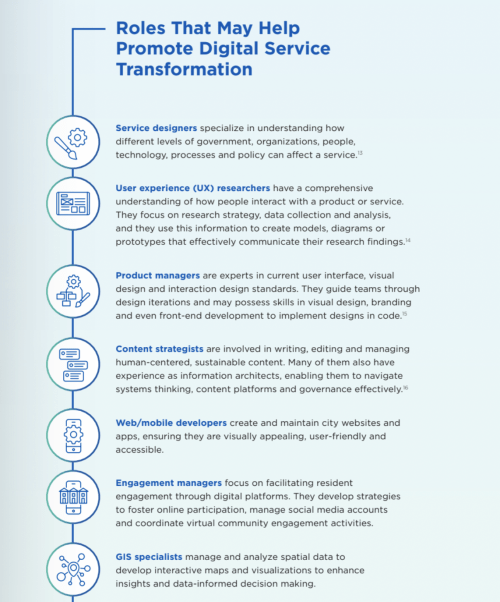 Read More
Read More
Going digital—to transform public services and people’s lives

City leaders almost always have at least one eye trained on uncovering new ways of working, whether it’s to deepen efficiencies, to keep in step with residents’ needs of government, or both. That means a growing number of cities are now focused on transforming their public services altogether—moving from an analog world to a digital one, where people can apply for a marriage license or housing benefits as easily as they can order groceries or make a restaurant reservation.
Many city leaders, however, are also expressing uncertainty about how to get started with this ambitious work, including how to develop effective goals, how to put teams in place, and how to execute and maintain momentum on these efforts. More specifically, they’re seeking guidance in “how to do this work in ways that incorporate accessibility, engagement, and co-creation of new solutions,” according to Lena Geraghty, the director of sustainability at the National League of Cities.
It’s with that need in mind that NLC, together with the Beeck Center for Social Impact and Innovation, just published a Municipal Action Guide on “Building Innovative Digital Services,” which spotlights critical steps cities should to take to realize their ambitions to better serve their communities, including:
- Defining digital goals and crafting a theory of change;
- Building and empowering a team;
- Designing with accessibility in mind; and,
- Addressing risks and challenges to transformation.
Defining digital goals and crafting a theory of change
The first step for any city’s digital transformation is articulating—and agreeing on—goals. Rather than starting with technology for technology’s sake, cities should look at their broad strategic objectives to determine how digital solutions can contribute to them. Then, by applying a theory of change—drawn from looking at the current state, crafting a desired end state, and articulating the means for bridging that gap—they can ensure everyone understands and endorses the way forward at both a strategic and a tactical level. Critically, this can also be used to communicate value to partners, helping to strengthen support for transformation efforts.
Understanding the needs and preferences of residents is, as always, essential. Surveys, focus groups, and public consultations can help distill insights into people’s expectations and pain points. Asking the right questions throughout the process can also help spark projects that weren’t, at first, even on a city’s radar. In Reykjavík, Iceland, one of six cities with Bloomberg Philanthropies-funded i-teams focused on leveraging digital technologies to enhance public services, this kind of end-user engagement helped prove that, as Mayor Dagur Eggertsson explained, “We have the residents with us in this.”
Building, empowering, and formalizing a team
Creating a successful digital transformation team is about more than just having people with the right experience, it’s also about creating a culture for that team’s success and then formalizing that team’s role in the way city hall now works. That often means starting with small-scale efforts that are more likely to be successful and, therefore, demonstrate value, and build support, throughout the organization.
The NLC report highlights Walnut Creek, Calif., which soon after hiring its first digital services director in 2021, set about redesigning a permitting and zoning website. By partnering with department directors, community development staff, and end users, the digital team made simple changes that improved accessibility in ways that resulted in marked uptick in transactions. The team’s early wins, which inspired additional requests from throughout the city and served as a building block for future success, “exemplifies that digital transformation extends beyond technology alone,” says NLC Urban Innovation Senior Specialist Chris Jordan.
Designing with accessibility in mind
Ambitious cities with great ideas might, at first, want to dig immediately into implementation. But it’s important to first take a beat to plan for accessibility, which will, ultimately, both save time and increase the number of people using the service. NLC points to a few concrete recommendations to make this happen: One is to include individuals with disabilities in the design and testing processes to ensure their voices are heard early on. Another is to use tools such as readability scores to ensure language content is accessible for a broad audience.
To this end, leaders in Hennepin County, Minn., created a User Experience Community of Practice (UXCOP) to help employees across different departments and roles collaborate on user experience and accessibility. This not only helped ensure an inclusive digital approach, it also created a new cross-department set of digital-transformation champions. The county was then able to create an accessibility policy with input from multiple departments and backing from the County leadership that will help all residents more easily interact with online services.
Successfully managing digital transformations
Digital transformation can be difficult. To effectively manage change, the guide recommends three critical steps. First, effectively engaging stakeholders—from department heads to community organizations—helps ensure that local governments build support for digital initiatives, rather than springing untested technology on unsuspecting audiences.
Next, it’s important to share digital-service wins publicly. That’s because positive changes are not always visible, especially in the early stages. Knowing about those changes can help build trust among residents, who won’t use anything they don’t trust. Being creative with positive outreach ensures that everyone hears about this wins, not just those who have opted in to government communications. That’s, for example, how city leaders in Scottsdale, Ariz., for example, used the Labor Day weekend to drive recent press coverage of, and resident engagement with, its Short-Term Rental Resource Center, which helps residents better understand how vacation rental sites like Airbnb and Vrbo are impacting their neighborhoods.
Finally, creating a culture of experimentation, innovation, and continuous improvement means that when projects fail teams are able to learn from them and improve, rather than throwing out the entire project (and accompanying team). The Beeck Center’s Digital Services Network hosts “FailFests” for teams to share stories about failures in a supportive environment, enabling multiple digital service teams to learn from each other.
While the guide provides a framework for cities, the ultimate hope is that municipalities will experiment with what works best for their residents, Geraghty says. “People are interested in doing this work thoughtfully,” she adds. “And we are interested in spreading some ideas and best practices and leave it up to local government leaders as to how they translate this to meet the needs of their community.”


